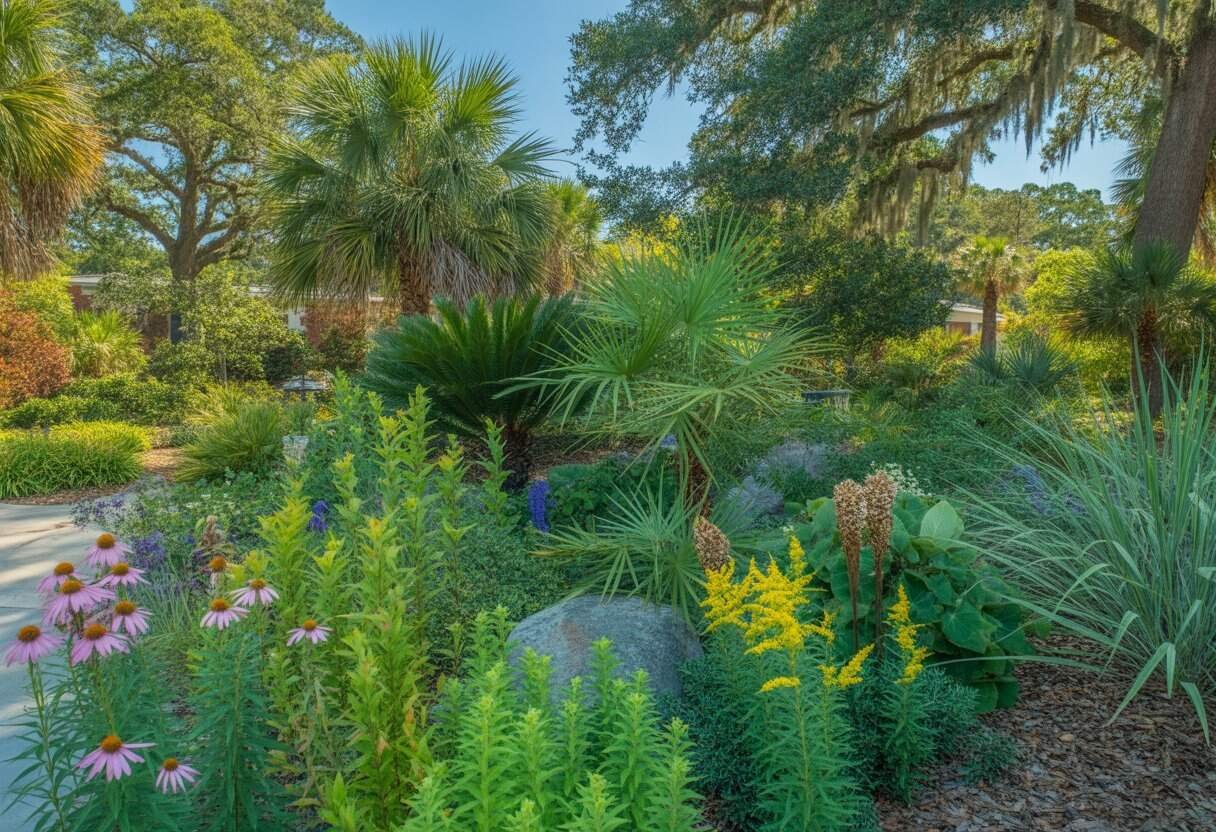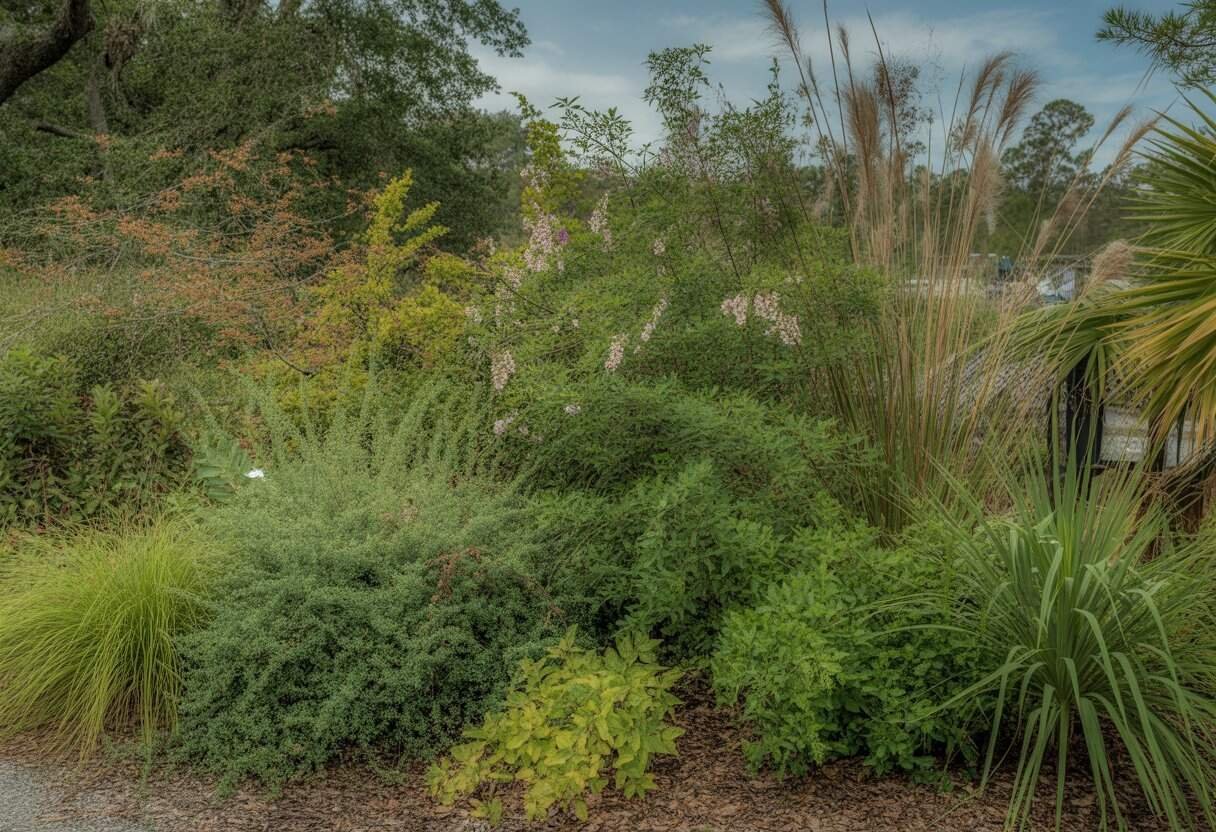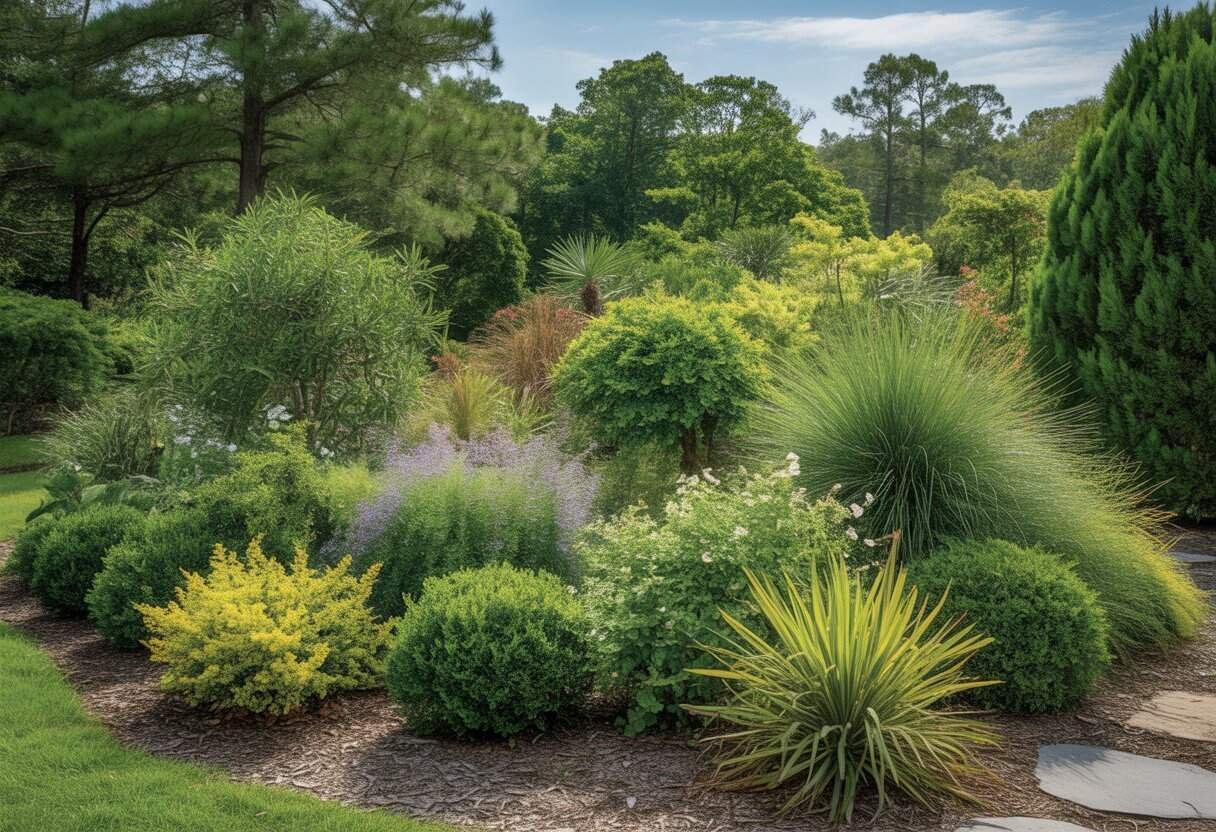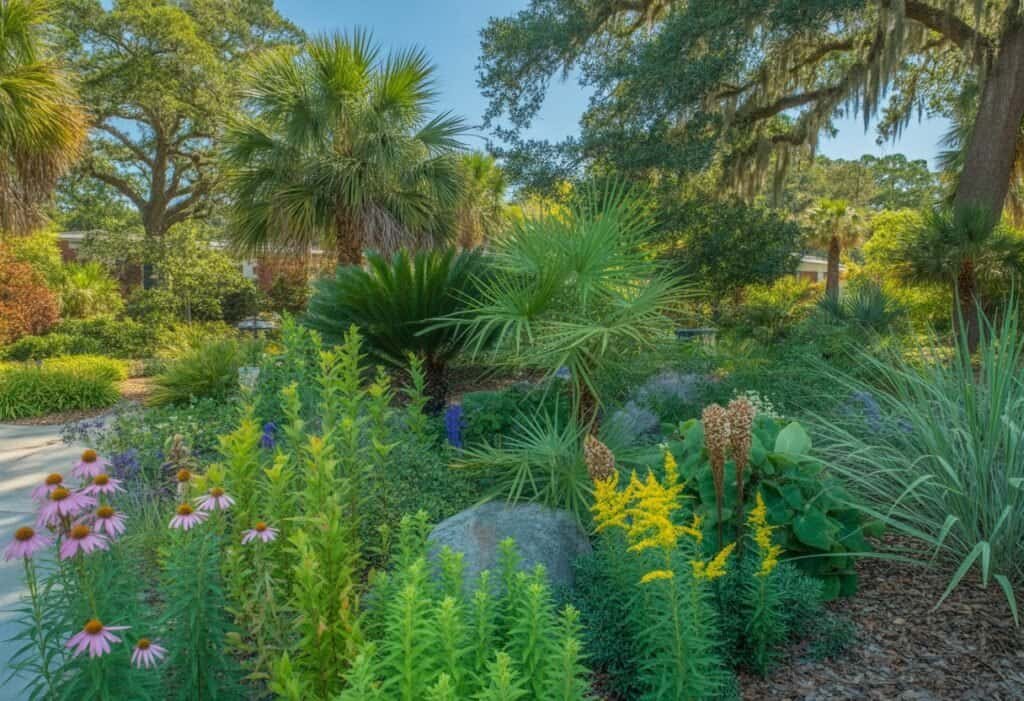South Carolina’s unique climate and soil conditions make it perfect for creating beautiful landscapes with native plants. Using plants that naturally grow in our state can transform your yard into a low-maintenance, environmentally friendly space.
Native plants have adapted to local conditions over thousands of years. They are resilient choices for any garden.

Landscaping with South Carolina native plants saves time, money, and resources while creating habitat for local wildlife. These plants typically need less water, fertilizer, and pest control than non-native species because they’ve evolved to thrive in our specific environment.
From the coastal plains to the piedmont and mountains, our state offers a rich diversity of native plants. You can find options suitable for every corner of your landscape.
Native plant landscapes support local pollinators like butterflies and bees. They also help reduce the spread of invasive species that can harm our natural areas.
Key Takeaways
- Native plant landscaping requires less maintenance and resources while supporting local wildlife ecosystems.
- South Carolina’s diverse regions offer native plant options for any landscape condition from shade to sun, wet to dry.
- Using native plants helps preserve South Carolina’s natural heritage and prevents the spread of potentially harmful invasive species.
Benefits of Using South Carolina Native Plants in Landscaping
Using native plants in your South Carolina landscape creates beautiful spaces. These plants offer ecological benefits and require less work to maintain.
Native plants have evolved in our local conditions over thousands of years. They are well-suited to South Carolina’s environment.
Supporting Local Wildlife
South Carolina native plants provide essential habitat and food sources for local wildlife. Birds, butterflies, and beneficial insects depend on these plants for survival.
Native flowering plants like Joe-Pye weed and Carolina jessamine offer rich nectar sources for pollinators. The monarch butterfly needs milkweed to complete its life cycle, while other butterflies rely on native host plants for their caterpillars.
Hummingbirds love red columbine and coral honeysuckle. These plants have evolved to match their feeding habits.
Native trees and shrubs provide nesting sites for birds and cover for small mammals. They supply food through berries, nuts, and seeds and offer year-round shelter from predators.
Environmental Advantages
Native plants boost biodiversity in your landscape. They create complex ecosystems that support many life forms and improve overall environmental health.
Their deep root systems help prevent erosion and filter water. This improves water quality in local streams and rivers.
During heavy rains, these plants absorb more water than non-natives. They help reduce runoff and flooding.
Most South Carolina natives are naturally drought tolerant once established. They thrive without supplemental watering and help conserve water during hot summer months.
Many native plants grow well in various soil conditions, including well-drained soil common in parts of South Carolina. They don’t need soil amendments or fertilizers that can harm waterways.
Low Maintenance Landscaping
Native plants reduce the time and money you spend on yard care. They’re already adapted to local conditions, so they need less water, fertilizer, and pest control than exotic species.
Once established, most native species need minimal intervention to thrive. This makes them perfect for busy homeowners or those looking to simplify their gardening routine.
Common maintenance benefits include less watering after establishment, fewer pest and disease issues, and minimal fertilizer needs. You also won’t need to prune as often.
Plants like muhly grass, black-eyed Susans, and Carolina jessamine naturally manage their growth. They require little attention.
Native plant communities also resist invasive species better than conventional landscapes. This reduces long-term maintenance issues.
Understanding South Carolina’s Native Plant Communities

South Carolina features distinct native plant communities adapted to the state’s varied landscapes. These plants have evolved with local soils, rainfall patterns, and climate conditions.
Coastal Plain Plant Ecosystems
The Coastal Plain of South Carolina hosts unique plant communities that thrive in sandy soils and maritime conditions. Native palmetto trees stand as iconic symbols of this region, providing habitat for wildlife and resilience against coastal storms.
Coastal leucothoe (Agarista populifolia) grows naturally in moist areas of the Coastal Plain. This evergreen shrub features arching branches and white bell-shaped flowers that bloom in spring.
Salt-tolerant species like sea oats and saltmeadow cordgrass stabilize dunes along the coast. These plants have specialized adaptations for surviving salt spray and shifting sands.
Pine savannas with longleaf pines support diverse understory plants, including wiregrass and many wildflower species. These ecosystems depend on periodic fires to maintain their open structure and biodiversity.
Piedmont and Upstate Flora
The Piedmont region showcases different plant communities adapted to clay soils and rolling terrain. Native oak-hickory forests dominate much of this landscape.
Piedmont azaleas bring dramatic spring color to these areas. The Oconee azalea (Rhododendron flammeum) produces flame-colored blooms in April.
Bottlebrush buckeye thrives in the dappled shade of Piedmont forests. This large shrub produces showy white flower spikes in early summer that attract pollinators.
Soil type strongly influences plant distribution in this region. Plants in the Piedmont have adapted to clay soils that retain moisture differently than coastal sands.
Wetlands and Riparian Habitats
South Carolina’s wetlands and stream banks support specialized plant communities adapted to periodic flooding and saturated soils. These areas serve as critical wildlife corridors and water filters.
Bald cypress and water tupelo trees dominate swamp forests. Their specialized “knees” help them survive in standing water.
These ancient trees create distinctive southern wetland landscapes. Plants here manage hydration naturally, adapting to varying water levels.
Some species tolerate complete submersion during floods. Others prefer the moist soils of stream banks.
Native sedges and rushes form the foundation of many wetland plant communities. These grass-like plants help prevent erosion along waterways and provide food and shelter for aquatic wildlife.
Selecting the Right Native Plants for Your Landscape

Choosing native plants for your South Carolina landscape starts with understanding your specific growing conditions. Native plants have adapted to local soils and climate, making them excellent low-maintenance choices.
Native Trees and Shrubs
Trees and shrubs form the backbone of any landscape design. South Carolina offers many beautiful native woody plants that provide structure, shade, and habitat.
The Southern Magnolia (Magnolia grandiflora) stands as an iconic choice with glossy evergreen leaves and fragrant white flowers. This majestic tree can reach 60-80 feet tall in optimal conditions.
American Holly (Ilex opaca) offers year-round interest with its distinctive spiny leaves and bright red berries. It grows 15-30 feet tall and provides excellent wildlife value.
For smaller spaces, consider Inkberry Holly (Ilex glabra), a compact evergreen shrub reaching 5-8 feet. It tolerates wet conditions and provides berries for birds.
Wild Rhododendron (Rhododendron catawbiense) thrives in partially shaded woodland settings. Its spectacular purple blooms appear in late spring.
South Carolina’s Native Flowering Plants
Flowering natives add seasonal color and support pollinators in your landscape design.
Fire Pink (Silene virginica) brings vibrant red star-shaped flowers that attract hummingbirds. This perennial blooms April through June and prefers well-drained soil in partial shade.
Crested Iris (Iris cristata) creates a delightful spring display with its lavender-blue flowers. Growing just 6-9 inches tall, it works beautifully in woodland gardens or shady borders.
Wild Columbine (Aquilegia canadensis) features unique nodding red and yellow flowers in spring. This adaptable plant tolerates part shade to sun and reaches 1-2 feet tall.
Popular Native Flowering Plants for South Carolina:
- Butterfly Weed (Asclepias tuberosa)
- Black-eyed Susan (Rudbeckia fulgida)
- Carolina Jessamine (Gelsemium sempervirens)
- Joe-Pye Weed (Eutrochium purpureum)
Native Ground Covers and Grasses
Ground covers and grasses provide essential soil stabilization. They also create visual transitions between larger landscape elements.
Green-and-gold (Chrysogonum virginianum) makes an excellent native ground cover with cheerful yellow flowers from spring through fall. It spreads gradually to form a dense carpet in partial shade.
Little Bluestem (Schizachyrium scoparium) offers multi-season interest with blue-green summer foliage that turns rusty orange in fall. This bunch grass reaches 2-3 feet tall and tolerates drought once established.
Pennsylvania Sedge (Carex pensylvanica) provides a lawn alternative for shady areas where grass struggles. This fine-textured sedge grows 6-10 inches tall and spreads slowly through rhizomes.
River Oats (Chasmanthium latifolium) feature distinctive dangling seedheads that persist through winter. This ornamental grass thrives in partial shade and reaches 2-3 feet tall.
Design Principles for Native Plant Landscaping
Creating beautiful landscapes with South Carolina native plants starts with thoughtful design. Good design considers plant communities, seasonal changes, and wildlife needs.
Incorporating Pollinator Gardens
Pollinator gardens attract beneficial insects and birds that help plants reproduce. When designing a pollinator garden, choose native species with different bloom times to provide continuous food sources.
Butterfly milkweed (Asclepias tuberosa) serves as a host plant for monarch butterflies and produces bright orange flowers. Bee balm (Monarda didyma) attracts hummingbirds and bees with its red tubular blooms.
Coral honeysuckle offers nectar for pollinators without the invasive tendencies of non-native honeysuckles. Goldenrod provides late-season pollen when many other plants have finished blooming.
Plant these species in clusters rather than as individual specimens. Pollinators find grouped plantings more easily.
Provide shallow water sources and areas of bare soil for ground-nesting bees. These features complete your pollinator habitat.
Creating Multi-Season Interest
A well-designed native landscape offers visual appeal throughout the year. Red maple provides spring flowers, summer shade, and brilliant fall color.
Blue star (Amsonia) delivers delicate blue spring flowers and golden fall foliage. Asters bloom in late summer through fall when many other plants have finished flowering.
Wild indigo (Baptisia) offers spring blooms followed by attractive seed pods that persist into winter. These pods add structure to the winter garden.
Mix grasses with broad-leaved plants for texture and contrast. Layer plants by height, placing taller species at the back of borders or center of island beds.
This approach creates depth and makes smaller plants more visible. Include evergreen natives to maintain structure during winter months.
Soil, Light, and Water Considerations
Creating a successful native plant landscape in South Carolina starts with understanding the specific soil, light, and water needs of local plants. These three elements form the foundation of any thriving garden and determine which native plants will flourish in your space.
Soil Types and Preparation
South Carolina has several distinct soil types, ranging from sandy coastal soils to clay-heavy Piedmont soils. Most native plants grow best in slightly acidic soil with a pH between 5.0 and 6.5, which is common throughout the state.
Test your soil before planting to determine its composition and pH. Local extension offices offer affordable soil testing services with detailed results.
For clay-heavy soils, add organic matter such as compost to improve drainage. Work 2-3 inches of compost into the top 6-8 inches of soil to create an ideal growing environment.
Sandy soils benefit from organic amendments that help retain water. Pine bark, leaf mold, and compost help sandy soil hold moisture without causing waterlogging.
Many South Carolina natives like Joe-Pye weed and Carolina jessamine adapt to different soil conditions. They still perform best in well-drained soil with added organic matter.
Light and Shade Preferences
South Carolina’s abundant sunshine makes plant selection based on light exposure important. Monitor your garden throughout the day to identify full sun (6+ hours), part shade (3-6 hours), and full shade (less than 3 hours) areas.
Full sun locations suit native plants like black-eyed Susans, butterfly weed, and native grasses. These plants thrive in intense sunlight and often bloom more vibrantly.
Part shade areas support woodland natives like wild ginger, foam flower, and native ferns. Carolina jessamine tolerates part shade but flowers more in sunny spots.
For deep shade under mature trees, choose native woodland species like Christmas fern, wild ginger, and trillium. These plants thrive in the dappled light of forest floors.
Watering and Drainage Best Practices
Most established South Carolina native plants need little supplemental watering, making them practical and eco-friendly for landscaping.
New plantings need consistent moisture during their first growing season. Water deeply 1-2 times per week to encourage deep root growth.
Proper drainage is essential for most native species. Even drought-tolerant plants can suffer in soggy conditions.
To test drainage, dig a 12-inch hole and fill it with water. If the water remains after 24 hours, improve drainage before planting.
Create berms or raised beds to manage water in poorly drained areas. These elevated areas prevent root rot in plants that need well-drained soil.
During drought, focus watering on recently planted natives. Established plants usually rely on natural rainfall.
Many native species like purple coneflower and yaupon holly tolerate drought well.
Avoiding Invasive Species and Encouraging Biodiversity
Creating a thriving native plant landscape requires vigilance against invasive species. Choosing native plants and removing invasives supports local wildlife and strengthens South Carolina’s ecosystems.
Identifying and Removing Invasives
Invasive plants in South Carolina include kudzu, English ivy, privet, and Japanese honeysuckle. These species crowd out natives and disrupt habitats.
Watch for signs of invasive plants:
- Rapid growth and spreading
- Few natural pests or diseases
- Abundant seed production
- Growth in many conditions
Pull out invasives by the roots when possible. For stubborn plants, use targeted herbicide applications. Always dispose of invasive material in sealed bags, not compost piles.
Monitor your landscape regularly to catch new invasions early. Spring and fall are good times to check for unwanted seedlings.
Supporting Native Ecosystems
Native plants form the foundation of healthy local ecosystems. They provide food and shelter for wildlife that evolved alongside them.
To increase biodiversity in your landscape:
- Plant in layers – Use ground covers, perennials, shrubs, and trees.
- Create habitat zones – Mix sunny and shady areas with different moisture levels.
- Add water features – Even small ponds support amphibians and beneficial insects.
Dense plantings of native species leave little room for invasives to take hold.
Consider plant communities instead of individual specimens. For example, pair oakleaf hydrangea with Christmas fern and wild ginger to mimic natural woodland edges.
Resources for South Carolina Native Plant Gardening
Several organizations and events offer guidance, plants, and community connections for gardeners interested in native species.
South Carolina Native Plant Society
The South Carolina Native Plant Society (SCNPS) is a leading resource for native plant enthusiasts. This non-profit promotes the appreciation and conservation of native plants across the state.
SCNPS offers educational workshops, field trips, and publications to help gardeners identify and use native species.
Members access specialized knowledge through regional chapters focused on local plants. Their website features plant lists by region and growing conditions.
The society also publishes seasonal newsletters with tips for gardening with native plants in South Carolina.
Connecting with Local Plant Sales and Events
Native plant sales offer opportunities to buy locally grown species and get expert advice. The Charleston Native Plant Sale, held twice a year, features hundreds of plants adapted to coastal conditions.
Community garden tours showcase successful native landscapes for inspiration. Public gardens like the South Carolina Botanical Garden in Clemson display native plant collections with labels and growing information.
Many county extension offices host workshops on using native plants in home landscapes. Local garden clubs often organize seed swaps for exchanging native plant seeds and tips.
Social media groups dedicated to South Carolina native plant gardening connect enthusiasts and provide real-time advice.
Frequently Asked Questions
South Carolina gardeners often have questions about using native plants in their landscapes. These plants offer beauty, resilience, and ecological benefits for the region.
What are some popular South Carolina native plants suitable for home landscaping?
Carolina jessamine produces bright yellow flowers and works well as a vine for trellises or fences. This state flower blooms from late winter through spring and attracts pollinators.
Eastern redbud trees show pink-purple blossoms in early spring before their heart-shaped leaves appear. They grow to 20-30 feet tall and offer both beauty and shade.
Black-eyed Susans display cheerful yellow blooms from summer through fall. These hardy perennials reach 2-3 feet tall and spread easily in sunny spots.
Butterfly weed produces vibrant orange flowers that attract monarchs and other butterflies. This drought-tolerant plant thrives in full sun with well-drained soil.
Can you suggest low maintenance native plants for a South Carolina garden?
Yaupon holly needs almost no maintenance once established. This evergreen shrub handles poor soil, drought, and coastal conditions.
Purple coneflower grows easily in average soil and full to partial sun. These flowers bloom for months and rarely need dividing or special care.
Muhly grass creates pink-purple plumes in fall. This ornamental grass tolerates drought, poor soil, and neglect.
American beautyberry develops purple berries in fall with minimal care. This shrub grows in sun or shade and needs little pruning.
Which native shrubs thrive best in South Carolina’s climate?
Oakleaf hydrangea produces white flower clusters and great fall color. This shrub prefers partial shade and handles heat and humidity well.
Wax myrtle works as an evergreen screen or hedge. This shrub tolerates wet or dry conditions and grows quickly to 10-15 feet.
Virginia sweetspire offers fragrant white flowers in spring and red-purple fall color. This shrub handles wet areas and clay soils.
Inkberry holly keeps glossy evergreen leaves year-round. This compact shrub reaches 5-8 feet tall and tolerates both wet and dry conditions.
Where can I find native plants for sale in South Carolina?
Native plant nurseries like Woodlanders in Aiken and Carolina Wild in Rock Hill specialize in indigenous species. These businesses provide expert advice with their plants.
Local garden centers increasingly stock native options, especially during spring and fall. Ask staff for plants native to the Carolinas.
Plant sales by botanical gardens, Master Gardener groups, and conservation organizations often feature native plants. These events usually occur in spring and fall.
Online sources like Mail Order Natives and Prairie Nursery ship South Carolina native plants directly to your door. Check their websites for availability and shipping details.
How can landscaping with indigenous plants benefit my South Carolina garden?
Native plants need less water once established, which lowers irrigation needs and water bills. Their deep root systems access groundwater during dry spells.
Indigenous species support local wildlife, providing food and habitat for birds, butterflies, and beneficial insects. This creates a living ecosystem in your yard.
Native plants often resist local pests and diseases better than exotic species. This natural resilience means fewer chemicals and healthier gardens.
Choosing regionally appropriate plants preserves South Carolina’s natural heritage and ecological balance. Each native garden helps counter habitat loss and supports biodiversity.
What are some top flower species native to South Carolina for a vibrant landscape?
Swamp milkweed produces pink flower clusters that attract monarch butterflies. This perennial thrives in moist areas and adapts well to average garden conditions.
Scarlet beebalm displays bright red tubular flowers that hummingbirds love. This aromatic perennial spreads slowly to form impressive colonies.
Wild blue phlox creates a carpet of lavender-blue flowers in spring. This woodland plant adds early color to partial shade gardens.
Joe-pye weed grows tall and shows off mauve flower clusters that attract butterflies. This late summer bloomer brings vertical interest to garden backgrounds.


